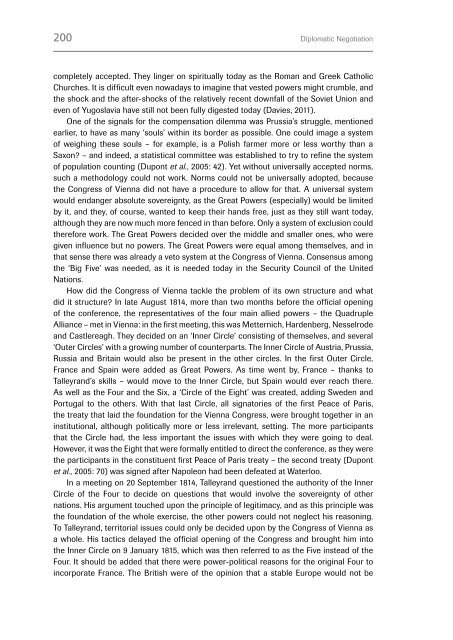Diplomatic Negotiation
Diplomatic_Negotiation_Web_2015
Diplomatic_Negotiation_Web_2015
Create successful ePaper yourself
Turn your PDF publications into a flip-book with our unique Google optimized e-Paper software.
200 <strong>Diplomatic</strong> <strong>Negotiation</strong><br />
completely accepted. They linger on spiritually today as the Roman and Greek Catholic<br />
Churches. It is difficult even nowadays to imagine that vested powers might crumble, and<br />
the shock and the after-shocks of the relatively recent downfall of the Soviet Union and<br />
even of Yugoslavia have still not been fully digested today (Davies, 2011).<br />
One of the signals for the compensation dilemma was Prussia’s struggle, mentioned<br />
earlier, to have as many ‘souls’ within its border as possible. One could image a system<br />
of weighing these souls – for example, is a Polish farmer more or less worthy than a<br />
Saxon? – and indeed, a statistical committee was established to try to refine the system<br />
of population counting (Dupont et al., 2005: 42). Yet without universally accepted norms,<br />
such a methodology could not work. Norms could not be universally adopted, because<br />
the Congress of Vienna did not have a procedure to allow for that. A universal system<br />
would endanger absolute sovereignty, as the Great Powers (especially) would be limited<br />
by it, and they, of course, wanted to keep their hands free, just as they still want today,<br />
although they are now much more fenced in than before. Only a system of exclusion could<br />
therefore work. The Great Powers decided over the middle and smaller ones, who were<br />
given influence but no powers. The Great Powers were equal among themselves, and in<br />
that sense there was already a veto system at the Congress of Vienna. Consensus among<br />
the ‘Big Five’ was needed, as it is needed today in the Security Council of the United<br />
Nations.<br />
How did the Congress of Vienna tackle the problem of its own structure and what<br />
did it structure? In late August 1814, more than two months before the official opening<br />
of the conference, the representatives of the four main allied powers – the Quadruple<br />
Alliance – met in Vienna: in the first meeting, this was Metternich, Hardenberg, Nesselrode<br />
and Castlereagh. They decided on an ‘Inner Circle’ consisting of themselves, and several<br />
‘Outer Circles’ with a growing number of counterparts. The Inner Circle of Austria, Prussia,<br />
Russia and Britain would also be present in the other circles. In the first Outer Circle,<br />
France and Spain were added as Great Powers. As time went by, France – thanks to<br />
Talleyrand’s skills – would move to the Inner Circle, but Spain would ever reach there.<br />
As well as the Four and the Six, a ‘Circle of the Eight’ was created, adding Sweden and<br />
Portugal to the others. With that last Circle, all signatories of the first Peace of Paris,<br />
the treaty that laid the foundation for the Vienna Congress, were brought together in an<br />
institutional, although politically more or less irrelevant, setting. The more participants<br />
that the Circle had, the less important the issues with which they were going to deal.<br />
However, it was the Eight that were formally entitled to direct the conference, as they were<br />
the participants in the constituent first Peace of Paris treaty – the second treaty (Dupont<br />
et al., 2005: 70) was signed after Napoleon had been defeated at Waterloo.<br />
In a meeting on 20 September 1814, Talleyrand questioned the authority of the Inner<br />
Circle of the Four to decide on questions that would involve the sovereignty of other<br />
nations. His argument touched upon the principle of legitimacy, and as this principle was<br />
the foundation of the whole exercise, the other powers could not neglect his reasoning.<br />
To Talleyrand, territorial issues could only be decided upon by the Congress of Vienna as<br />
a whole. His tactics delayed the official opening of the Congress and brought him into<br />
the Inner Circle on 9 January 1815, which was then referred to as the Five instead of the<br />
Four. It should be added that there were power-political reasons for the original Four to<br />
incorporate France. The British were of the opinion that a stable Europe would not be


